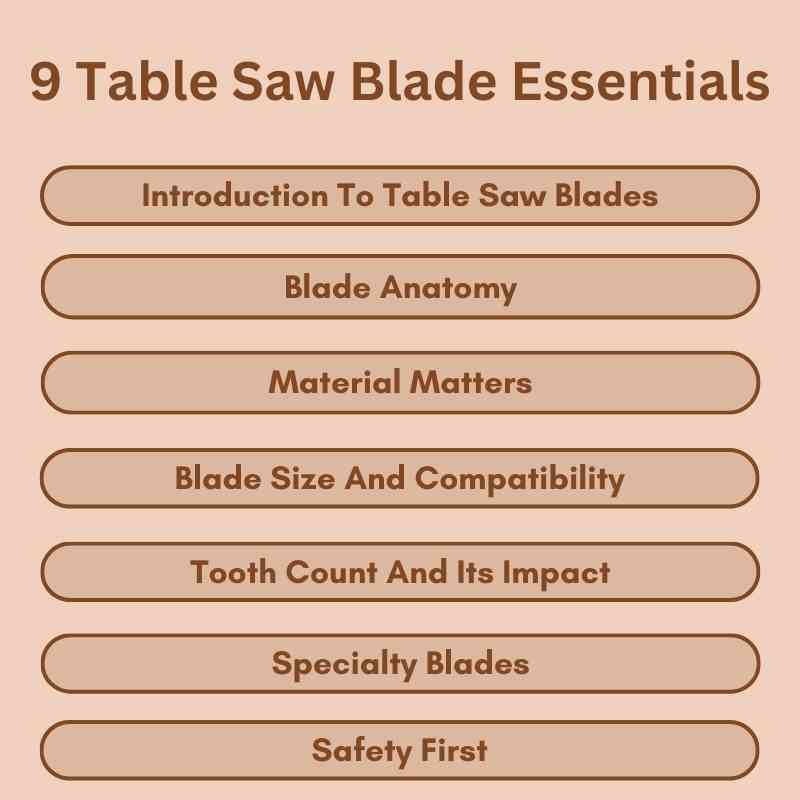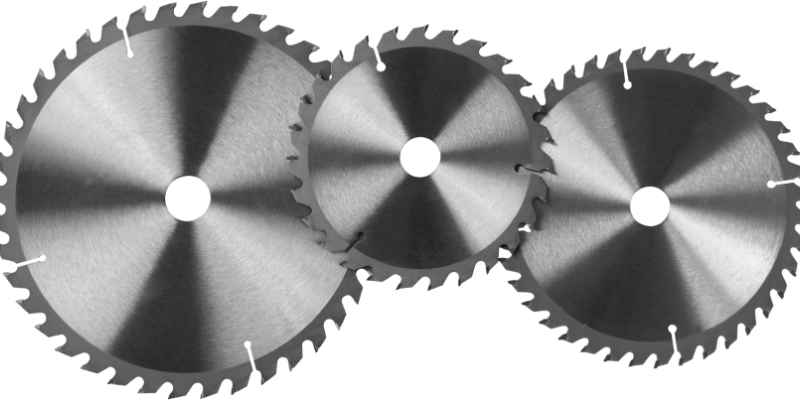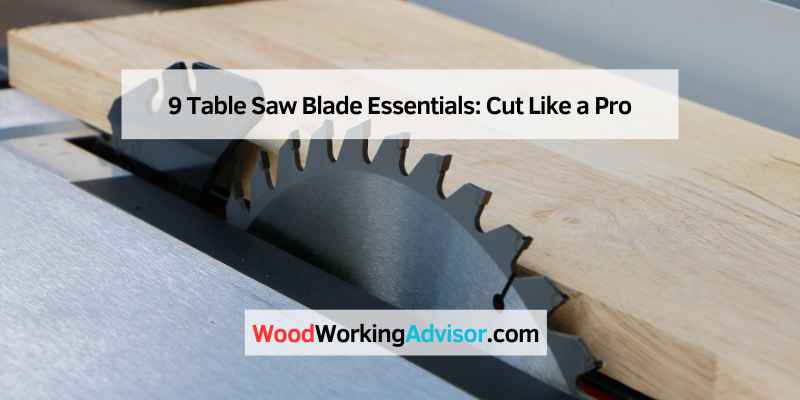A 9-inch table saw blade is designed for precision cutting in woodworking projects. It offers versatility and efficiency for various materials.
Table saw blades come in different sizes and types, with the 9-inch blade being particularly popular among hobbyists and professionals alike. This size strikes a balance between cutting depth and maneuverability, making it ideal for various tasks. From ripping lumber to cross-cutting plywood, a 9-inch blade can handle diverse materials efficiently.
Choosing the right blade ensures cleaner cuts and extends the life of your saw. Understanding the different tooth configurations and materials available will help you select the perfect blade for your specific needs. Investing in quality blades enhances the overall performance of your table saw and elevates your woodworking projects.
Introduction To Table Saw Blades
Table saw blades are essential tools for woodworkers. They determine the quality of cuts and the speed of your work. Understanding different types of blades is crucial for effective woodworking. Each blade serves a specific purpose, making your projects easier and more precise.
The Heart Of The Table Saw
The table saw blade is the heart of the table saw. It spins at high speeds, slicing through wood with ease. Choosing the right blade affects your project’s outcome.
Here are key components of table saw blades:
- Diameter: Common sizes are 10 inches and 12 inches.
- Teeth Count: More teeth offer smoother cuts; fewer teeth cut faster.
- Kerf: This is the width of the cut. Thinner kerfs waste less material.
Types Of Cuts And Blade Selection
Selecting the right blade for your needs is vital. Different blades are designed for various cuts. Here’s a breakdown of common types:
| Blade Type | Teeth Count | Best For |
|---|---|---|
| Rip Blade | 24-30 | Ripping lumber along the grain |
| Crosscut Blade | 40-60 | Cutting across the grain |
| Combination Blade | 50 | Both ripping and crosscutting |
| dado Blade | Various | Creating grooves and dadoes |
Choose wisely to achieve your desired results. Quality blades lead to better cuts and save time. Always match the blade to the task for optimal performance.

Blade Anatomy
Understanding the anatomy of a table saw blade is crucial. Each part plays a significant role in cutting performance. Let’s explore the key elements that make up a table saw blade.
Understanding Teeth Configuration
The teeth configuration affects cutting efficiency and quality. Here are some common types:
| Teeth Configuration | Description | Best For |
|---|---|---|
| Flat Top Grind (FTG) | Teeth are flat and square. | Ripping wood. |
| Alternate Top Bevel (ATB) | Teeth alternate between bevels. | Crosscutting and general use. |
| Triple Chip Grind (TCG) | Combines flat and angled teeth. | Cutting hard materials. |
Choosing the right teeth configuration enhances your project. Each type serves a specific purpose, helping you achieve a cleaner cut.
Kerf: The Blade’s Thickness
Kerf refers to the thickness of the cut made by the blade. It affects how much material is wasted during cutting. Here are some key points:
- Thin Kerf: Less material is removed. Ideal for softer woods.
- Standard Kerf: More stability. Suitable for general cutting.
- Thick Kerf: More robust. Best for heavy-duty cutting tasks.
Choose the right kerf for your projects. A thin kerf blade is great for saving material. A thick kerf blade offers more durability.
Material Matters
Choosing the right table saw blade material is crucial. The material impacts performance, durability, and cutting quality. Understanding blade materials helps you select the best option for your projects.
Choosing The Right Blade Material
Table saw blades come in various materials. Each material has unique properties. Here are the common materials:
- High Carbon Steel (HCS)
- High-Speed Steel (HSS)
- Carbide-Tipped Steel
Each type has its benefits:
| Material | Advantages | Disadvantages |
|---|---|---|
| High Carbon Steel | Sharp edges, easy to sharpen | Wears out quickly |
| High-Speed Steel | High durability, heat resistant | More expensive |
| Carbide-Tipped Steel | Long-lasting, excellent cutting | More brittle |
Steel Vs. Carbide Blades
Steel blades are affordable. They work well for softwood and light tasks. However, they dull quickly.
Carbide blades are more expensive. They provide sharp, long-lasting edges. They perform well on hardwood and tough materials.
Consider these factors for your choice:
- Project type
- Material thickness
- Frequency of use
Choosing the right material enhances your table saw’s performance. Make your projects easier and more enjoyable.
Blade Size And Compatibility
Choosing the right blade size is crucial for effective cutting. Proper compatibility between the blade and saw ensures safety and performance. Understanding standard sizes helps in selecting the best blade for your projects.
Standard Sizes And Their Uses
Table saw blades come in various sizes. Here are the most common sizes:
| Blade Size | Common Use |
|---|---|
| 10 inches | General purpose cutting |
| 8 inches | Smaller projects and tighter spaces |
| 12 inches | Thicker materials and larger cuts |
Each size serves different needs:
- 10-inch blades: Ideal for most woodworking tasks.
- 8-inch blades: Great for compact saws.
- 12-inch blades: Best for heavy-duty applications.
Ensuring Blade And Saw Compatibility
Compatibility between the blade and saw is vital. Follow these guidelines:
- Check the saw’s specifications.
- Verify the arbor size.
- Ensure the blade thickness fits the saw’s guard.
Using the wrong size can lead to:
- Unsafe operations
- Poor cutting performance
- Damage to equipment
Always consult the manufacturer’s guidelines. Proper installation enhances safety and efficiency.
Tooth Count And Its Impact
The tooth count on a table saw blade plays a crucial role. It affects the quality of cuts. Understanding this can help you choose the right blade.
Balancing Speed And Finish
Tooth count influences both speed and finish quality. Fewer teeth cut faster but leave rough edges. More teeth produce cleaner cuts but slow down the process.
Here’s a quick overview:
| Tooth Count | Cutting Speed | Finish Quality |
|---|---|---|
| 24 Teeth | Fast | Rough |
| 40 Teeth | Moderate | Good |
| 80 Teeth | Slow | Excellent |
More Teeth For Fine Cuts
Using blades with more teeth is best for fine cuts. They create smooth edges on hardwood and plywood. Ideal for projects needing precision.
- Use 80-tooth blades for fine woodworking.
- Great for laminate and veneer.
- Minimizes splintering and chipping.
Consider the following:
- Choose fewer teeth for fast crosscuts.
- Select more teeth for detailed rip cuts.
- Find a balance that suits your project.
Specialty Blades
Specialty blades enhance the function of your table saw. They are designed for specific tasks. Using the right blade can improve precision and efficiency. Let’s explore two essential types of specialty blades.
Dado Blades For Joinery
Dado blades create grooves and joints efficiently. They come in various sizes and configurations. Here are some key features:
- Stackable Design: Combine multiple blades for desired width.
- Adjustable Width: Easily change the width of cuts.
- Clean Cuts: Produces smooth edges for joints.
Ideal uses for dado blades include:
- Making dado joints.
- Creating rabbet cuts.
- Cutting grooves for plywood edges.
Combination Blades For Versatility
Combination blades serve multiple purposes. They handle crosscuts and rip cuts well. These blades have both fine and coarse teeth.
Benefits of combination blades include:
- Versatile Use: Suitable for various materials.
- Cost-Effective: One blade for multiple tasks.
- Quality Cuts: Provides smooth finishes.
Common applications for combination blades:
- Ripping hardwoods.
- Crosscutting softwoods.
- General woodworking projects.
Maintenance For Longevity
Proper maintenance is crucial for the lifespan of your table saw blades. Regular care keeps blades sharp and efficient. Follow these tips for cleaning and sharpening to ensure long-lasting performance.
Cleaning Your Blades
Keeping your table saw blades clean enhances their performance. Remove resin, pitch, and dust that build up during use. Here’s how to clean your blades effectively:
- Use a soft brush to remove loose debris.
- Soak blades in a cleaning solution for 15 minutes.
- Scrub with a non-abrasive pad.
- Rinse under warm water and dry thoroughly.
- Apply a light coat of oil to prevent rust.
Sharpening Tips For Continued Precision
Sharp blades make cleaner cuts. Regular sharpening maintains precision. Here are essential tips:
- Check blade sharpness before each use.
- Use a sharpening jig for accurate angles.
- Sharpen blades when they show signs of dullness.
- Consider professional sharpening every few months.
Follow these steps to keep your table saw blades in top shape. Regular maintenance ensures precise cuts and a longer lifespan.
Safety First
Using a table saw requires attention to safety. Proper measures protect you from accidents. Always prioritize safety to enjoy woodworking.
Proper Handling And Storage
Safe handling and storage of table saw blades are crucial. Follow these tips:
- Store blades in a protective case. This prevents damage and injury.
- Keep blades away from children. Store them in a secure location.
- Label blades. Mark each blade for easy identification.
- Inspect blades regularly. Look for chips or cracks before use.
Proper handling reduces the risk of accidents. Always carry blades with care.
Safety Practices During Use
Following safety practices during use is vital. Here are essential rules:
- Wear protective gear. Use safety goggles and ear protection.
- Use the right blade. Match the blade to your material.
- Keep hands clear. Use push sticks for guiding wood.
- Adjust blade height properly. Only expose the necessary part.
- Turn off the saw. Unplug it when changing blades.
Always stay focused while using the saw. Avoid distractions to prevent injuries.
Advanced Tips
Master your table saw with these advanced tips. These techniques enhance precision and efficiency. Learn how to fine-tune your saw and troubleshoot common issues.
Fine-tuning For Precision Cuts
Precision is key for high-quality cuts. Follow these steps to fine-tune your table saw:
- Blade Alignment: Ensure the blade is parallel to the miter slot.
- Height Adjustment: Set the blade height for your material thickness.
- Bevel Angle: Adjust the bevel to achieve precise angles.
- Throat Plate: Use a zero-clearance throat plate for better support.
Use a caliper to measure the blade’s alignment. A slight adjustment can make a big difference. Regular checks help maintain accuracy.
Troubleshooting Common Issues
Even experienced users face issues. Here are common problems and solutions:
| Issue | Solution |
|---|---|
| Blade Binding: | Check for debris and adjust the fence. |
| Uneven Cuts: | Realign the blade and check the table surface. |
| Excessive Vibration: | Inspect blade tension and replace if worn. |
| Burn Marks: | Adjust feed rate and blade sharpness. |
Keep a maintenance log. Regular checks prevent bigger issues. This will extend the life of your table saw.

Frequently Asked Questions
What Are The Types Of Table Saw Blades?
Table saw blades come in various types, each designed for specific tasks. Common types include rip blades, crosscut blades, combination blades, and dado blades. Rip blades are ideal for cutting with the grain, while crosscut blades excel at cutting against the grain.
Choose the right blade for your project.
How To Choose The Right Table Saw Blade?
To choose the right table saw blade, consider the material and cut type. Determine if you need a rip, crosscut, or combination blade. Also, check the tooth count; more teeth provide smoother cuts. Lastly, ensure the blade diameter matches your saw specifications for optimal performance.
What Is The Best Table Saw Blade For Hardwood?
The best table saw blade for hardwood is usually a combination blade. These blades offer a balance of rip and crosscut capabilities, making them versatile. Look for blades with 40 to 60 teeth for smooth cuts. Brands like Freud and DeWalt are popular for high-quality hardwood blades.
How Often Should I Replace My Table Saw Blade?
Replace your table saw blade when it shows signs of wear. Dull blades can lead to poor cuts and increased effort. Generally, a well-maintained blade can last for several months. However, frequent use or cutting tough materials may require more regular replacements for optimal performance.
Conclusion
Choosing the right table saw blade can significantly enhance your woodworking projects. Each type of blade serves a specific purpose, ensuring clean cuts and improved efficiency. By understanding your needs and selecting the appropriate blade, you can achieve professional results.
Invest wisely, and your table saw will become an invaluable tool.

